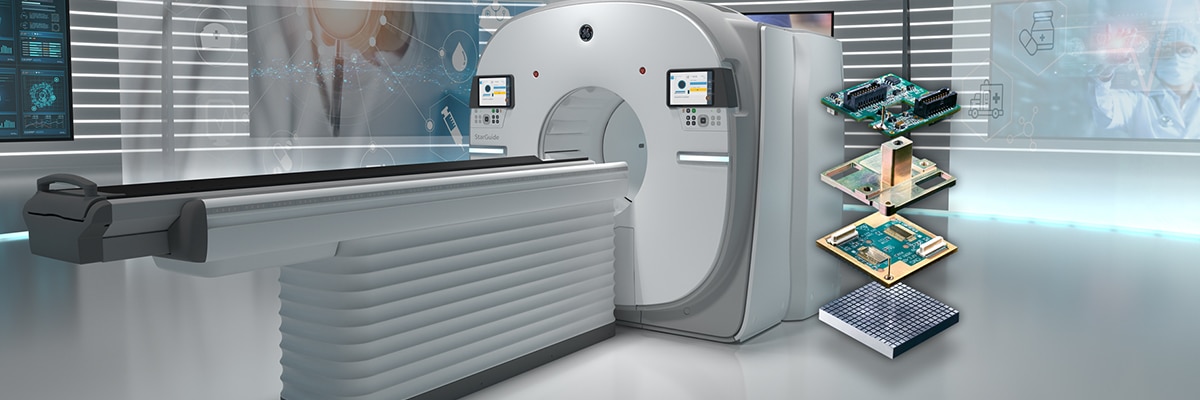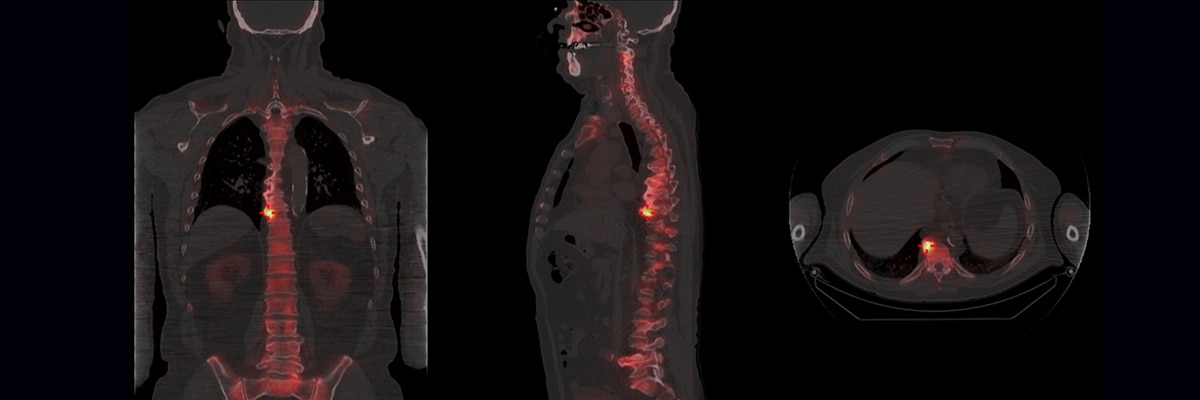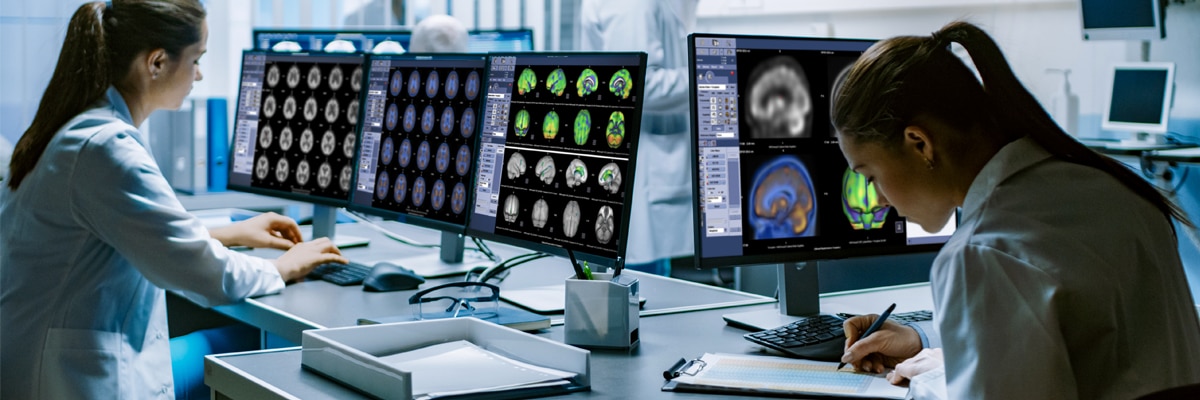Precision imaging at the speed of tomorrow
Introducing StarGuide, our most advanced SPECT/CT featuring advanced Cadmium Zinc Telluride (CZT) technology designed to usher in a new era of discovery for Nuclear Medicine. Physicians and researchers utilizing its powerful, GE Healthcare-developed CZT technology need such tools to explore and expand the understanding of the patient condition, and help improve patient outcomes.
StarGuide is a valuable asset for those providers who see pathways toward effective treatments that have yet to be explored. The many technologies and productivity tools at the heart of StarGuide are provided to help physicians lead the way toward effective medical care while maintaining the ability to deliver efficient imaging solutions within demanding clinical environments.
exploration and discoveryUnlock the potential of Theranostics and highly personalized care
StarGuide provides accurate quantitation to help clinicians make personalized care decisions and treatment response assessments that are at the heart of Theranostics by striking the right balance of energy resolution and spatial resolution.
Each of StarGuide’s 12 CZT Digital Focus Detectors supports a wide energy range capable of imaging the dual energy peaks of tracers used in Theranostics, such as the 113 keV and 208 keV emission peaks of 177Lu used to diagnose and evaluate treatment response for prostate cancer².
StarGuide is optimized for 177Lu imaging, enabled by its improved energy resolution, system sensitivity, and system planar resolution for 177Lu high and low energy peaks as compared to a NaI system³. This enables 177Lu imaging without the need for collimator exchange — typically needed in dual head cameras — simplifying day-to-day clinical workflow and patient scheduling.
Leverage our leadership to your patient’s advantage
GE Healthcare is at the forefront of molecular imaging, and has been since we began development of the first commercially available SPECT/CT scanner in 1999 and PET/CT in 2000. To maintain our leadership position, we have established the CZT Center of Excellence in Rehovot, Israel, where we continuously develop advanced, proprietary CZT technology found exclusively in GE Healthcare’s Nuclear Imaging products.
Our commitment to meeting our customers’ nuclear medicine needs extends to the manufacture and distribution of radiopharmaceutical products as well. Through GE Healthcare’s Pharmaceutical Diagnostics (PDx) division, we’re the only medical equipment manufacturer with the ability to develop and supply highly specialized pharmaceuticals to clinical and research institutions throughout the world.
Our most advanced CZT detectors
StarGuide’s Digital Focus Detectors are designed to propel SPECT imaging to new heights in performance by maximizing the amount of information to help you gain true insight into the patient condition. After optimizing the detector and bed positions from the Optical Scout data, StarGuide’s constellation of 12 slim Digital Focus Detectors orbit the body as closely as possible, and from all necessary angles, to scan the target area — and not the air surrounding the patient. The result is a high-resolution scan and minimization of patient time on the camera.
CZT detector technology features a higher count rate over conventional detector technologies. StarGuide’s intrinsic count rate is greater than 700 kcnts/second with no detector saturation or resulting dead time.
The resolution to see more, learn more
The CZT material at the heart of each Digital Focus Detector provides an inherently high contrast-to-noise ratio. Its 2.46 mm² pixel size and 8 mm spatial resolution⁴ deliver the clarity you need to detect, locate, and quantify diseases at an early stage – helping to open the door to more effective treatments and improved patient outcomes.
StarGuide delivers a remarkable 5.9% energy resolution when scanning ⁹⁹ᵐTc, and <5% energy resolution when scanning 177Lu at its 208 keV peak. With such superb energy resolution, StarGuide gives you the ability to effectively differentiate between simultaneously acquired isotopes with smaller differences in peak energies.
reconstructionProcess more high-definition data
StarGuide’s image processing engine is designed to help physicians advance from analog 2D scanning to digital 3D scanning in their pursuit of true insight into the patient condition. The 12 Digital Focus Detectors scanning in 3D generate exponentially more data than previous 2D scans, significantly increasing the processing power of StarGuide’s image processing engine to efficiently calculate the thousands of additional vectors, variable bed positions, and other factors. The result is a high-quality image.
Innovative physicians looking to navigate molecular imaging’s unexplored regions will appreciate that StarGuide’s image processing engine offers highly customizable reconstruction capabilities in addition to a robust set of default protocols to steer their pursuits in any direction they choose.
Q.Clear: full convergence reconstruction
The Q.Clear reconstruction algorithm represents a significant step forward for use in SPECT imaging, including in the assessment of treatment response in addition to the diagnosis and staging of disease. This advancement is made possible by suppressing noise to provide outstanding quantitation accuracy without sacrificing StarGuide’s ability to accurately determine lesion size and volume.
productivitySmartConsole
SmartConsole is our latest network-capable image processing sub-system for Nuclear Medicine that enables you to automate SPECT/CT reconstruction, simplify complex hybrid imaging and quantitative protocols, and generate high-quality hybrid images so you can make informed decisions that lead to quantifiable results. SmartConsole is optimized to host our latest reconstruction algorithms and applications, plus it helps you seamlessly clarify and share patient data.
SmartConsole includes FAME post-processing, which integrates the CT anatomical bone information into the SPECT bone image processing. When used on StarGuide images, the lesion detectability is improved, which helps increase diagnostic confidence⁷.
Swift Plan
Swift Plan workflow is designed to simplify clinician interactions with a scanner as fast and sophisticated as StarGuide. By leveraging proven GE Healthcare innovations like its interactive table ruler and our advanced automation robotics, then combining them with new innovations like our intuitive bedside display and Optical Scout, Swift Plan quickly becomes an extremely capable and user-friendly productivity enhancer.
Swift Plan with SmartConsole automates SPECT/CT reconstruction, simplifies complex hybrid and quantitative protocols, optimizes image quality with retrospective processing features, reduces errors, allows operators to see images at the scanner console, and enables physicians to review scans remotely. Even with a long list of capabilities, the learning curve for Swift Plan is remarkably short.
Explore Nuclear Medicine’s potential while enhancing clinical care
When you consider the number of breakthrough technologies built into StarGuide, it’s easy to understand why it’s regarded as such an advanced and capable research tool. But there is much more to the StarGuide story than discovery. Many of StarGuide’s efficiencies, including Optical Scout, its predictable and repeatable scan times, and digital productivity tools also make it reliable enough to perform routine scanning procedures in demanding clinical environments, which will bring peace-of-mind to your institution’s management team.







